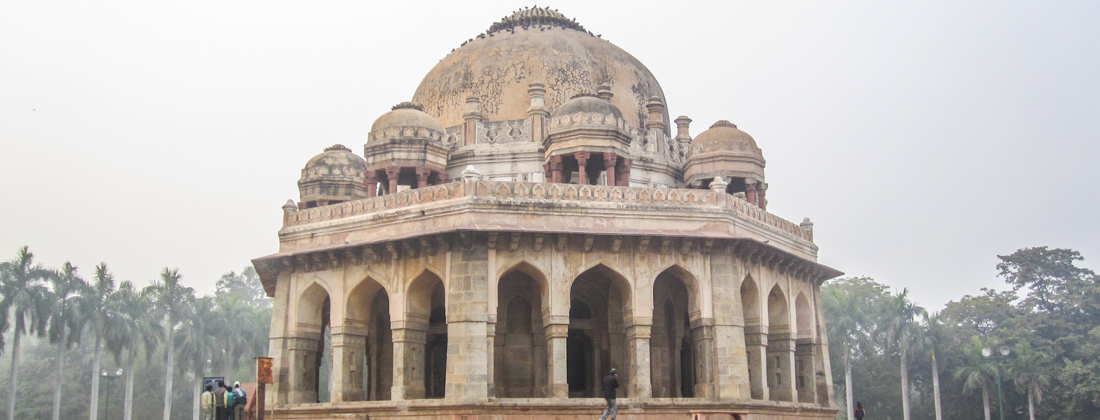
Delhi – Places to Visit
Agra
With Delhi and Jaipur, Agra is the third cornerstone of the famous North Indian “Golden Triangle”. With its Taj Mahal, it is an impressive tourist landmark. The largest part of the city is on the western bank of the Yamuna. The Taj Mahal itself is the center around which the town has extended outward. To the west of the Taj Mahal is Agra Fort, right on the banks of the river. From the fort, you can see the Taj Mahal, in the middle of its gardens, surrounded by walls. The Taj Mahal was built over a period of more than 20 years by Mughal Emperor Shah Jahan, as a tomb for his wife Mumtaz Mahal.
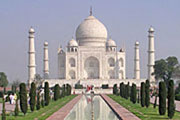 The tomb is located on a platform surrounded by four minarets, at the northern end of gardens decorated in the famed Charbagh style. The central dome of the Taj Mahal is 55 m high. The entire complex looks particularly impressive from close quarters, and visitors admire both the grandeur of the overall impression and the extraordinary detail of its sculpture, further accentuated by the flower-shaped inlays of semi-precious stones. And within are the tombs of Mumtaz Mahal and Shah Jahan, crafted from marble and set with exquisite inlays. The Taj Mahal certainly warrants more than one visit, with its appearance changing with the different lighting conditions during the day.
The tomb is located on a platform surrounded by four minarets, at the northern end of gardens decorated in the famed Charbagh style. The central dome of the Taj Mahal is 55 m high. The entire complex looks particularly impressive from close quarters, and visitors admire both the grandeur of the overall impression and the extraordinary detail of its sculpture, further accentuated by the flower-shaped inlays of semi-precious stones. And within are the tombs of Mumtaz Mahal and Shah Jahan, crafted from marble and set with exquisite inlays. The Taj Mahal certainly warrants more than one visit, with its appearance changing with the different lighting conditions during the day.
Bharatpur or Keoladeo National Park
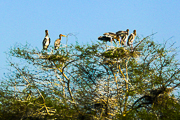 This park was formerly known as the Bharatpur Bird Sanctuary and was reserved for hunting by the royal family. Several species of herons have their habitat here, such as the Purple Heron, the Grey Heron and the Indian Pond Heron. Other bird species present include the painted stork, Eurasian spoonbill, white ibis and gray pelican From October to March, the area is home to 130 species of migratory birds that come from faraway places, such as Russia, to winter here. The park is also a habitat for wild boar, mongoose, deer (including the “spotted deer”) and antelopes. The best times to visit are at sunrise and at sunset.
This park was formerly known as the Bharatpur Bird Sanctuary and was reserved for hunting by the royal family. Several species of herons have their habitat here, such as the Purple Heron, the Grey Heron and the Indian Pond Heron. Other bird species present include the painted stork, Eurasian spoonbill, white ibis and gray pelican From October to March, the area is home to 130 species of migratory birds that come from faraway places, such as Russia, to winter here. The park is also a habitat for wild boar, mongoose, deer (including the “spotted deer”) and antelopes. The best times to visit are at sunrise and at sunset.
Fatehpur Sikri
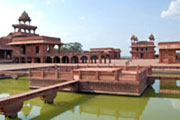 Fatehpur Sikri, built between 1569 and 1585 by the Mughal Emperor Akbar, served as the new capital. But by 1600 it had already been abandoned due to persistent water shortages. The city presents itself with an impressive combination of Islamic and Hindu arts and crafts. Within the royal palace is the spacious Diwan-i-Am, a courtyard for public audiences, while next to it rises the Diwan-i-Khas, the area for private audiences, a two-storey building with corner kiosks. Inside is a single room with a unique circular throne platform. From here, Akbar led discussions with followers of various religions, seated hidden behind ornate partitions. The throne pillar is shaped in the form of a lotus (a symbol from Hinduism and Buddhism), with the royal shield of honor (Hinduism) and the tree of life (Islam). The foot of the throne’s pillar is decorated with Islamic, Hindu, Christian and Buddhist motifs in four sections. Other attractions include the “Dawlat Khana” (the private rooms of the ruler, decorated with the most impressive sculptures), the palace of Birbal, the Jami Masjid and the grave of Sheikh Salim Chishti.
Fatehpur Sikri, built between 1569 and 1585 by the Mughal Emperor Akbar, served as the new capital. But by 1600 it had already been abandoned due to persistent water shortages. The city presents itself with an impressive combination of Islamic and Hindu arts and crafts. Within the royal palace is the spacious Diwan-i-Am, a courtyard for public audiences, while next to it rises the Diwan-i-Khas, the area for private audiences, a two-storey building with corner kiosks. Inside is a single room with a unique circular throne platform. From here, Akbar led discussions with followers of various religions, seated hidden behind ornate partitions. The throne pillar is shaped in the form of a lotus (a symbol from Hinduism and Buddhism), with the royal shield of honor (Hinduism) and the tree of life (Islam). The foot of the throne’s pillar is decorated with Islamic, Hindu, Christian and Buddhist motifs in four sections. Other attractions include the “Dawlat Khana” (the private rooms of the ruler, decorated with the most impressive sculptures), the palace of Birbal, the Jami Masjid and the grave of Sheikh Salim Chishti.
Khajuraho
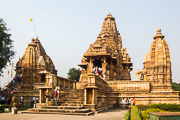 A fascinating insight into the art of the Chandellas is offered by the Khajuraho group of temples, consisting of 25 temples in all. The temples, well-known especially for their explicit erotic reliefs, were built between the 10th and 12th century from fine-grained sandstone. Most spectacular is the Western group with the Kandariya Mahadeva Temple, the Vishwanatha Temple and the Lakshmana Temple. The site is considered an outstanding example of Indo-Aryan architecture and is located in a well kept complex with numerous red-flowering bougainvillea bushes. Even around the temples, one comes across many artistically valuable sculptures. As a whole, the motifs of the sculptures and friezes illustrate the daily lives of people in the Indian royal court in the 10th and 11th century. Only about 5% of the sculptures are erotic in nature. The depicted lovemaking scenes symbolically illustrate the philosophy and road to enlightenment of Tantrism. The soft sandstone used to build the temple facilitated an unusually detailed design of the motifs. The ornate wall sculptures appear to be almost three-dimensional. The temple architecture is uniquely based on a three-or five-part layout. Almost all temples are lined up on an east-west axis, with the entrance facing east. The otherwise conventional enclosure becomes redundant due to the confining effect of the high base. Between December and February, a spectacular dance festival is held here in connection with the Maha Shivaratri festival, with representatives of the many forms of traditional Indian dance.
A fascinating insight into the art of the Chandellas is offered by the Khajuraho group of temples, consisting of 25 temples in all. The temples, well-known especially for their explicit erotic reliefs, were built between the 10th and 12th century from fine-grained sandstone. Most spectacular is the Western group with the Kandariya Mahadeva Temple, the Vishwanatha Temple and the Lakshmana Temple. The site is considered an outstanding example of Indo-Aryan architecture and is located in a well kept complex with numerous red-flowering bougainvillea bushes. Even around the temples, one comes across many artistically valuable sculptures. As a whole, the motifs of the sculptures and friezes illustrate the daily lives of people in the Indian royal court in the 10th and 11th century. Only about 5% of the sculptures are erotic in nature. The depicted lovemaking scenes symbolically illustrate the philosophy and road to enlightenment of Tantrism. The soft sandstone used to build the temple facilitated an unusually detailed design of the motifs. The ornate wall sculptures appear to be almost three-dimensional. The temple architecture is uniquely based on a three-or five-part layout. Almost all temples are lined up on an east-west axis, with the entrance facing east. The otherwise conventional enclosure becomes redundant due to the confining effect of the high base. Between December and February, a spectacular dance festival is held here in connection with the Maha Shivaratri festival, with representatives of the many forms of traditional Indian dance.
Sanchi
The Great Stupa of Sanchi is one of the earliest religious structures on the subcontinent. It towers over a complex of ruins with the remains of temples and monasteries that, as a whole, document the development of Buddhist art and architecture in central India. Unlike other Buddhist sites in eastern India and Nepal, Sanchi shares no direct connection with the life of Buddha. With the construction of the stupa by the Maurya Emperor Ashoka in the 3rd century BC, the place developed into an important pilgrimage center. Sanchi is a very special place that is definitely worth a visit by travelers who are in the area. In contrast to the simple form of the hemispherical stupa, the gates of the stone enclosure are covered by magnificent reliefs which are among the most important artistic achievements in India because of the influence their style had on other major areas in Central and South India.
Sikandra
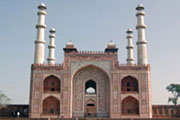 The tomb of Mughal emperor Akbar is located in the small town of Sikandra. Situated in a quiet garden, the architectural design of the tomb is an excellent example of the combination of different styles. The magnificent main entrance, the use of ornamental motifs and Persian calligraphy, the decorative cutout patterns, the ornate garden and the multi-storey minarets clearly show the prevailing Islamic influence. Traditional local style elements however manifest themselves on large roof domes and in the integration of the pavilions.
The tomb of Mughal emperor Akbar is located in the small town of Sikandra. Situated in a quiet garden, the architectural design of the tomb is an excellent example of the combination of different styles. The magnificent main entrance, the use of ornamental motifs and Persian calligraphy, the decorative cutout patterns, the ornate garden and the multi-storey minarets clearly show the prevailing Islamic influence. Traditional local style elements however manifest themselves on large roof domes and in the integration of the pavilions.
